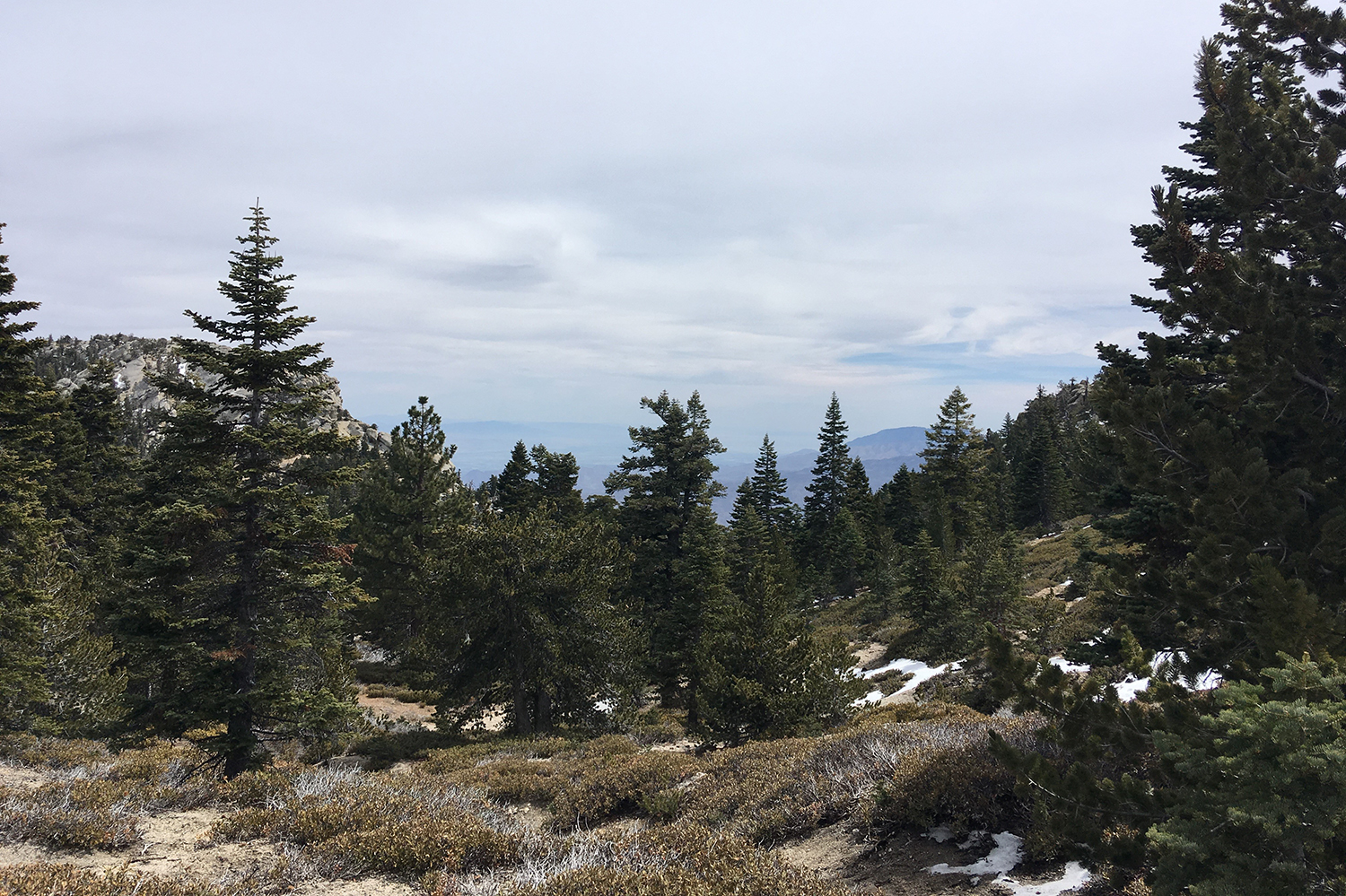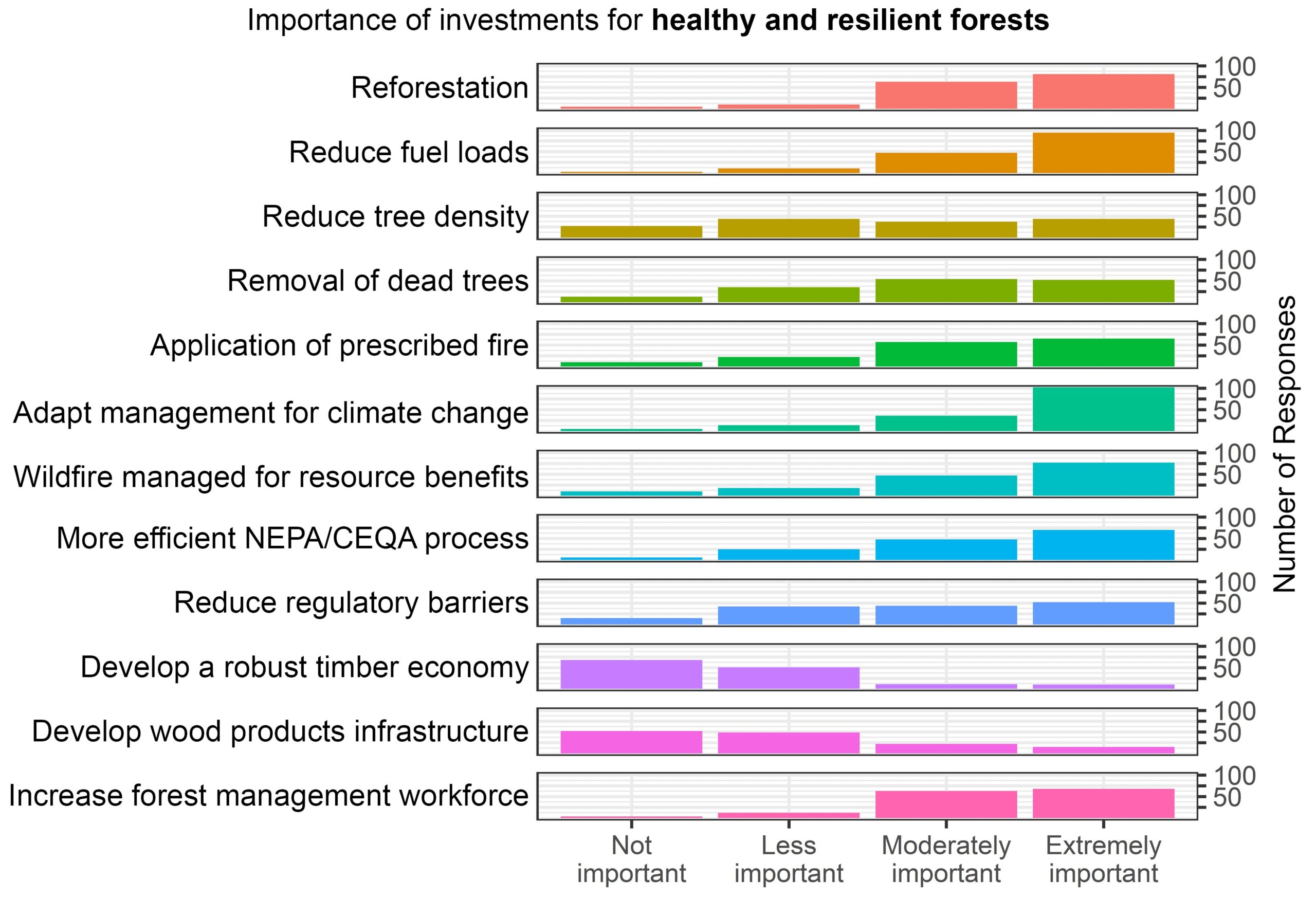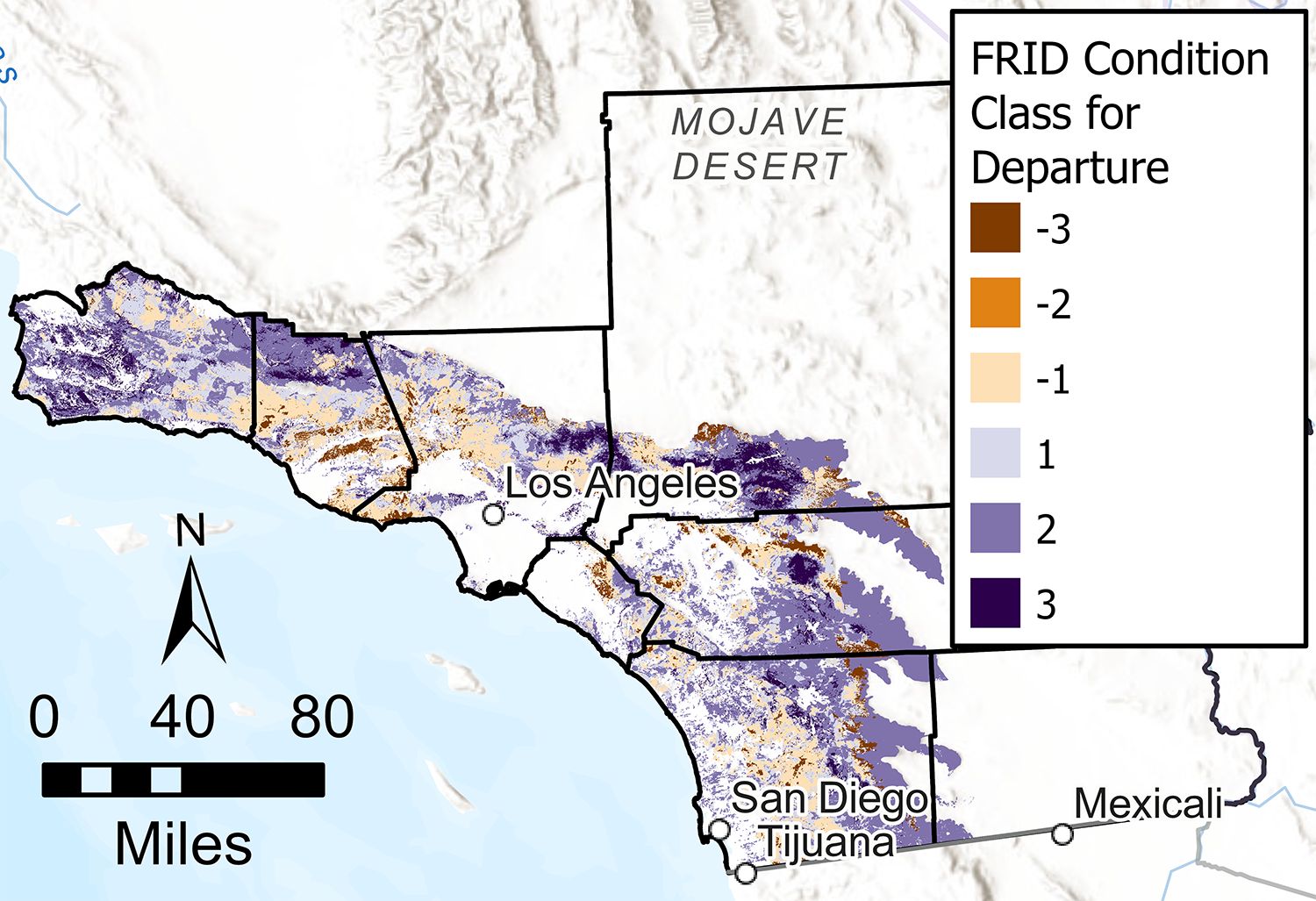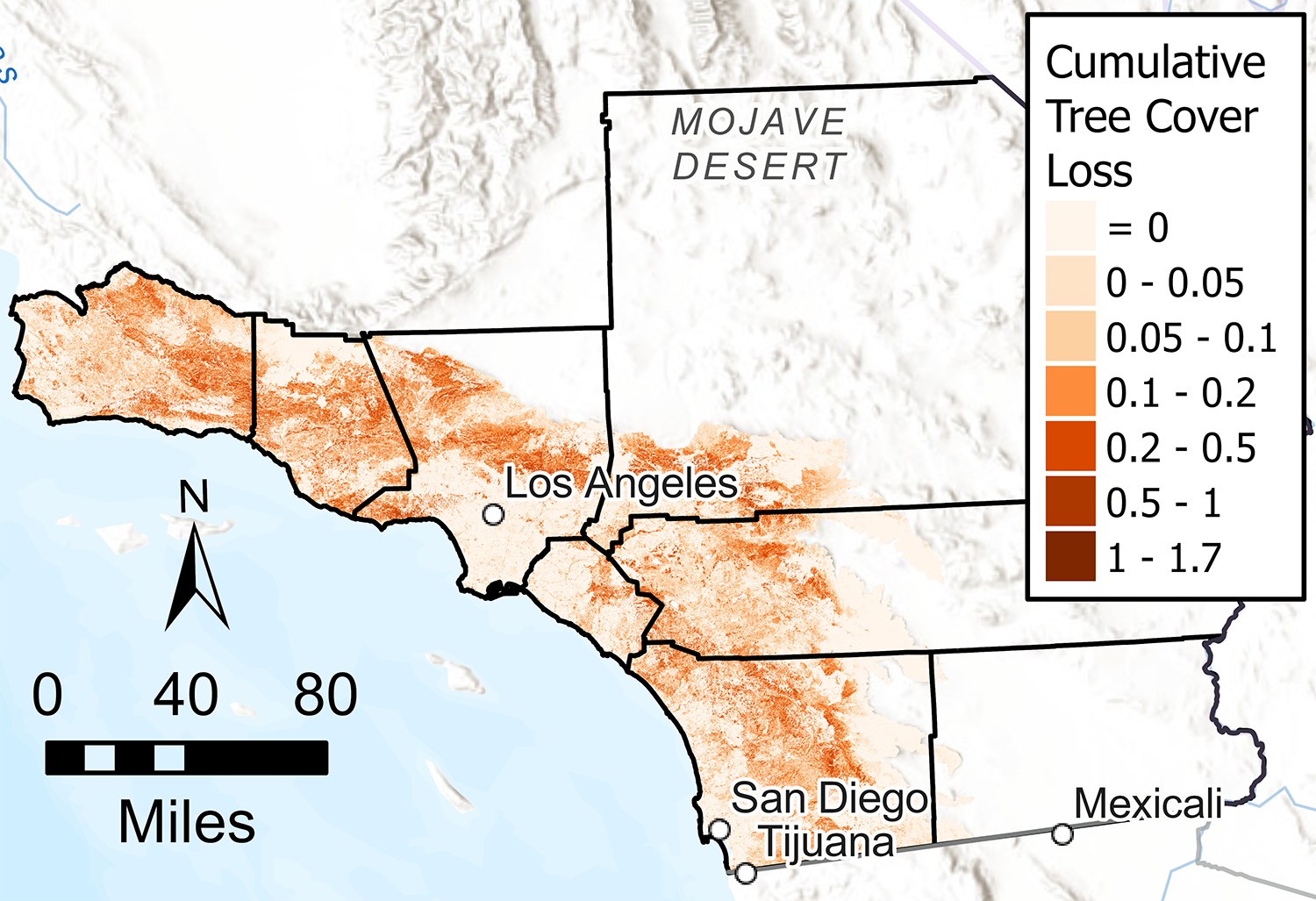Southern California Regional Profile
HEALTHY & RESILIENT FORESTS

Overview
Although forested lands have a smaller footprint in this region, Southern California’s forests provide vital ecosystem services, including protecting key watersheds, sequestering carbon and offering recreational opportunities. As in other regions, forests and woodlands in Southern California are threatened by climate change, invasive species, development of natural lands, and increasingly large and severe wildfires. Threats and management priorities vary by forest type.
Montane forests
Montane forests in Southern California mostly occur within the four National Forests and are often referred to as “sky islands” because they are restricted to high-elevation mountain habitat. Similar to the Sierra Nevada region, montane forests are dominated by pine and fir species, and the natural fire regime was characterized by frequent, low to moderate-severity fires. Lightning-ignited fires generally occur from late-summer to fall in the western Transverse Range (Los Padres and Angeles National Forests), and in spring-early summer in the Southern Peninsular Range (Cleveland National Forest), with the San Bernardino mountains situated at an intermediate point along this gradient. Before EuroAmerican settlement, the mean fire return interval was 7-15 years; however, 20th century fire suppression policies caused these forests to burn less frequently. This is the opposite of what is occurring in shrublands at lower elevations, where fire is igniting much more frequently than naturally occurred.
Suppression of the natural fire regime has resulted in denser forests dominated with smaller trees, more ladder fuels, and the build-up of surface fuels. Accumulated ladder and surface fuels increase the likelihood that fire will move into the forest canopy and burn with greater intensity, resulting in severe ecosystem effects. Drier conditions associated with climate change have also promoted high levels of tree mortality. The combination of high intensity fires and tree mortality has significantly inhibited the ability of forests to regenerate and recover. As a result, many forested areas are changing to shrublands. In recent decades, 14% of montane forest cover was lost in Southern California. This is over twice the rate of tree cover loss experienced across the entire state (6.7%), suggesting that forests in Southern California are less capable of recovering from wildfire than in other regions.
Management treatments are being applied to help increase and restore natural forest ecosystem dynamics and resilience. Healthy forest conditions result when trees are patchily distributed in terms of tree spacing and across size classes. Management actions that reduce forest density, such as selective tree thinning and fuel treatments, can alleviate competition for water resources and encourage the growth of larger trees that are more resilient to fire and able to store more carbon. In some areas, such as Mount Laguna in the Cleveland National Forest, efforts are also being made to reintroduce low-intensity fire and reduce fuel loads through prescribed burning to mitigate the risk of larger, unmanaged wildfires occurring.
Riparian forests
Southern California riparian forests grow along stream and river corridors and are dominated by deciduous species, such as willows, sycamores, cottonwoods, alders, and live oaks. Historically, riparian forests functioned as natural fire breaks. However, the invasion of nonnative species, particularly arundo (giant cane) and tamarisk (salt cedar), has increased the presence of flammable, dry, vegetation that increase fire ignition risk and fuel fire spread. Because nonnatives often recover quicker than native trees post-fire, future wildfire risk continues to increase as nonnative plants become more dominant in riparian forests. Human management of invasive plant species is essential for both protecting native riparian forest habitat and reducing wildfire hazard.
Oak woodlands
Oak woodlands are another ecologically and culturally important ecosystem of Southern California. This habitat is composed of a mosaic of grassland, shrubland, and woodland patches. For thousands of years, ancestral land managers used fire to manage oak woodlands for resource benefits, such as improving acorn crops and stimulating the growth of plants used for weaving baskets. A historic fire regime of high-frequency, low-severity burning facilitated the growth of large, mature, trees that were resilient to wildfire and also prevented shrub invasion. However, the 19th century displacement of Indigenous peoples and outlawing of cultural burning, followed by the 20th century policy of fire suppression, disrupted the historic fire regime. Today, fuels have accumulated in oak woodland habitat and increased the risk of larger, more severe fires. Recently, there has been increased support for restoring cultural burning practices and further incorporating traditional ecological knowledge into land management.
Unfortunately, Southern California oak trees are experiencing significant mortality due to invasive pests. The Goldspotted Oak Borer (GSOB) is a small beetle that preys on drought-stricken oak trees. First discovered in San Diego County in 2004, it has since spread to Riverside, Orange, Los Angeles and San Bernardino Counties, and there is significant risk that it will continue to spread northward. Because GSOB is largely spread by the transportation of firewood, it is imperative that recreators do not move firewood from where it originated. Management actions are currently focused on monitoring and limiting the spread of GSOB to new areas, protecting healthy trees, removing dead trees that can fuel wildfires, and reforesting.
Stakeholder Perspectives

Survey respondents rated reducing fuel loads, adapting management for climate change, reforestation, and increasing forest management workforce as important areas of investment for achieving healthy and resilient forests. Developing a robust timber economy and wood products infrastructure were perceived by respondents to be low priorities for the region.
Interviewees emphasized the urgency in and importance of protecting montane forests, because this already rare habitat is being lost to disturbance and previously forested areas are converting to shrublands. Many interviewees also expressed concern that Southern California forests have received much less research attention than Northern California forests and it’s often assumed that research findings and best management practices developed in the northern regions can be applied to Southern California forests. Interviewees noted that more research was needed to understand the historic fire ecology of Southern California forests, how the forests are changing due to current disturbances, and what management actions are effective for increasing forest resilience.
.
Resource Conditions


Forest health and resilience can be assessed by a variety of metrics, including those related to fire return interval departure (FRID) (A) and tree cover loss (B). The length of time between wildfires influences the positive and negative impacts the fire has on ecosystem health and resilience. Fire return interval departure describes the difference between current and historical fire frequencies. This is important because areas with highly departed fire frequencies may be at high risk of reduced resilience and, therefore, a priority for management actions. Positive FRID condition values indicate fires are burning less frequently than historical regimes, while negative values indicate fires are burning more frequently than historical regimes. The higher the condition class value, the greater the departure from an area’s historical fire return interval. Chaparral landscapes in the region, therefore, fall into negative condition classes, while forested landscapes have positive condition classes. Measuring cumulative loss of tree cover can also inform forest management; in the regional resource kit tree cover is a continuous variable from 0 to 1.
